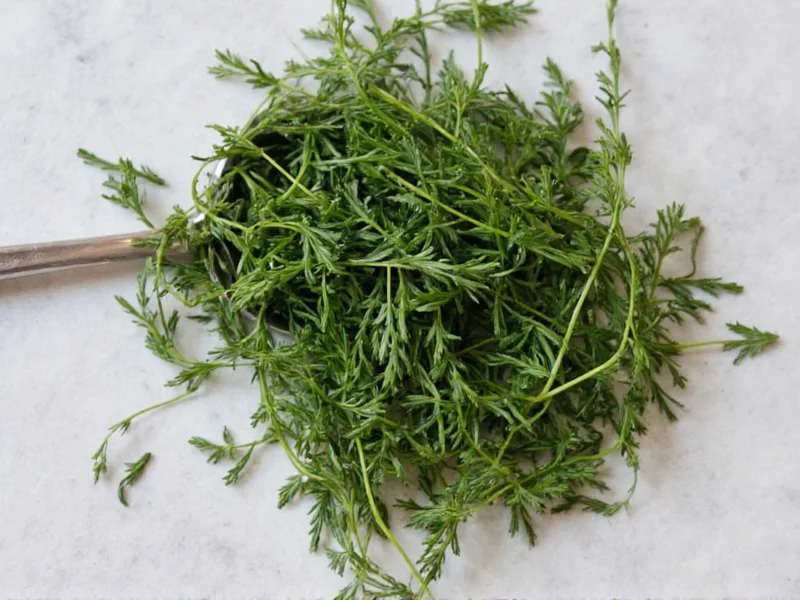When converting fresh dill to dried in your recipes, understanding the proper measurement ratio is essential for achieving balanced flavors. The standard conversion is straightforward: 1 tablespoon of fresh dill equals 1 teaspoon of dried dill. This 3:1 ratio exists because the drying process removes moisture while concentrating the essential oils and flavor compounds in the herb.
Why the 3:1 Fresh to Dried Herb Ratio Matters
Dill, like most fresh herbs, contains approximately 80-90% water. When dried, this moisture evaporates, leaving behind a more concentrated form of the herb's essential oils and flavor compounds. This concentration explains why you need less dried dill to achieve similar flavor intensity as fresh.
Chefs and home cooks often make the mistake of using equal measurements when substituting, resulting in either under-seasoned dishes (when using too little dried herb) or overpowering flavors (when using too much). Getting this conversion right significantly impacts the final taste of your recipes, particularly in delicate dishes like salads, fish preparations, and pickling solutions where dill plays a starring role.
Fresh Dill to Dried Dill Conversion Chart
| Fresh Dill | Dried Dill | Best Used For |
|---|---|---|
| 1 teaspoon | ⅓ teaspoon | Finishing touches, garnishes|
| 1 tablespoon | 1 teaspoon | Standard recipe measurements|
| ¼ cup | 1¼ tablespoons | Sauces, dressings, marinades|
| ½ cup | 2½ tablespoons | Pickling brines, hearty dishes|
| 1 cup | 5 tablespoons (⅓ cup) | Large batch recipes, preserving
Practical Substitution Tips for Cooking
When substituting dried dill for fresh in your recipes, consider these professional cooking tips:
- Add dried herbs earlier: Incorporate dried dill at the beginning of cooking to allow time for rehydration and flavor release, while fresh dill should be added in the last few minutes to preserve its delicate flavor.
- Adjust for dish type: In liquid-based recipes like soups and stews, you can sometimes use slightly less dried dill (try ¾ teaspoon instead of 1 teaspoon) as the liquid helps distribute the flavor.
- Consider quality factors: Older dried dill loses potency, so you may need to increase the amount slightly if your dried herbs have been stored for more than 6 months.
- Taste as you go: Always taste your dish after adding dried herbs and allow 5-10 minutes for flavors to meld before adjusting seasoning.
When Fresh and Dried Dill Aren't Interchangeable
While the tablespoon fresh dill to dried conversion works for most applications, certain recipes truly require one form over the other:
- Fresh dill is essential for dishes where texture matters, such as dill dip, tzatziki, or as a garnish for finished dishes where the visual appeal of fresh fronds enhances presentation.
- Dried dill works better in long-cooking applications like pickling brines, where fresh dill would become mushy and lose its distinctive flavor profile.
- For baking applications like dill bread or crackers, dried dill distributes more evenly throughout the dough.
Maximizing Flavor in Your Dill-Forward Recipes
To get the most from your dill substitutions, consider these flavor-enhancing techniques:
- Bloom dried dill in a small amount of warm oil or broth before adding to your recipe to release maximum flavor compounds.
- Combine forms strategically - use mostly dried dill for base flavor during cooking, then finish with a small amount of fresh dill for brightness.
- Store dried dill properly in an airtight container away from light and heat to maintain potency for up to 1-2 years.
- Crush dried dill between your fingers before adding to release essential oils and improve flavor distribution.
Common Measurement Mistakes to Avoid
Many home cooks make these errors when converting tablespoon fresh dill to dried:
- Using equal measurements (1:1 ratio) instead of the proper 3:1 conversion
- Not accounting for the age of dried herbs (older = less potent)
- Adding dried dill at the same stage as fresh would be added
- Not tasting and adjusting after the flavors have time to meld
- Using the same conversion for all herbs (different herbs have different concentration ratios)
Recipe-Specific Conversion Guidance
Different types of recipes may require slight adjustments to the standard tablespoon fresh dill to dried conversion:
- For salad dressings: Use the standard 1 tbsp fresh = 1 tsp dried ratio, but add dried dill to the vinegar component first to help rehydrate it.
- In pickling recipes: Increase dried dill by 25% (1 tbsp fresh = 1¼ tsp dried) as the brine solution dilutes flavors.
- For fish dishes: Be conservative with dried dill (1 tbsp fresh = ¾ tsp dried) as fish has delicate flavors easily overwhelmed by strong herbs.
- In baked goods: Use the standard ratio but consider adding a pinch of lemon zest to compensate for the brightness lost when using dried instead of fresh.











 浙公网安备
33010002000092号
浙公网安备
33010002000092号 浙B2-20120091-4
浙B2-20120091-4